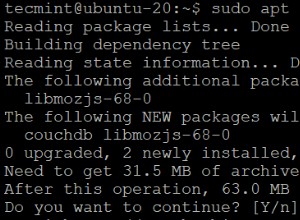Das Aktivieren des Cachings in der Spring Boot-App ist sehr einfach. Sie müssten nur drei Schritte befolgen.
- Cache-Konfiguration definieren
- EnableCaching zu einer beliebigen Konfigurationsklasse hinzufügen
- Stellen Sie eine CacheManager-Bean bereit
Für Redis haben wir RedisCacheManager, der konfiguriert und erstellt werden kann.
Cache-Konfiguration
@Configuration
@Getter
@Setter
@ConfigurationProperties(prefix = "cache")
public class CacheConfigurationProperties {
// Redis host name
private String redisHost;
// Redis port
private int redisPort;
// Default TTL
private long timeoutSeconds;
// TTL per cache, add enties for each cache
private Map<String, Long> cacheTtls;
}
Legen Sie ihre Werte über Eigenschaften oder Yaml-Dateien wie
festcache.redisHost=localhost
cache.redisPort=6379
cache.timeoutSeconds=1000
cache.cacheTtls.cach1=100
cache.cacheTtls.cach2=200
Nachdem Sie die Konfiguration erstellt haben, können Sie die Cache-Konfiguration für RedisCacheManger per Builder erstellen.
@Configuration
@EnableCaching
public class CacheConfig {
private static RedisCacheConfiguration createCacheConfiguration(long timeoutInSeconds) {
return RedisCacheConfiguration.defaultCacheConfig()
.entryTtl(Duration.ofSeconds(timeoutInSeconds));
}
@Bean
public LettuceConnectionFactory redisConnectionFactory(CacheConfigurationProperties properties) {
RedisStandaloneConfiguration redisStandaloneConfiguration = new RedisStandaloneConfiguration();
redisStandaloneConfiguration.setHostName(properties.getRedisHost());
redisStandaloneConfiguration.setPort(properties.getRedisPort());
return new LettuceConnectionFactory(redisStandaloneConfiguration);
}
@Bean
public RedisCacheConfiguration cacheConfiguration(CacheConfigurationProperties properties) {
return createCacheConfiguration(properties.getTimeoutSeconds());
}
@Bean
public CacheManager cacheManager(
RedisConnectionFactory redisConnectionFactory, CacheConfigurationProperties properties) {
Map<String, RedisCacheConfiguration> cacheConfigurations = new HashMap<>();
for (Entry<String, Long> cacheNameAndTimeout : properties.getCacheTtls().entrySet()) {
cacheConfigurations.put(
cacheNameAndTimeout.getKey(), createCacheConfiguration(cacheNameAndTimeout.getValue()));
}
return RedisCacheManager.builder(redisConnectionFactory)
.cacheDefaults(cacheConfiguration(properties))
.withInitialCacheConfigurations(cacheConfigurations)
.build();
}
}
Wenn Sie Redis-Cluster verwenden, aktualisieren Sie die Cache-Eigenschaften entsprechend. In diesem Fall würden einige Beans primär werden, wenn Sie Cache-spezifische Beans wünschen, als diese Methoden privat zu machen.




